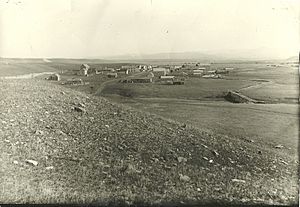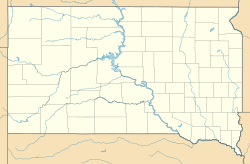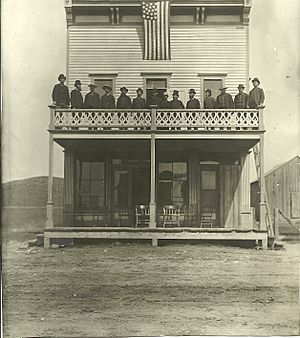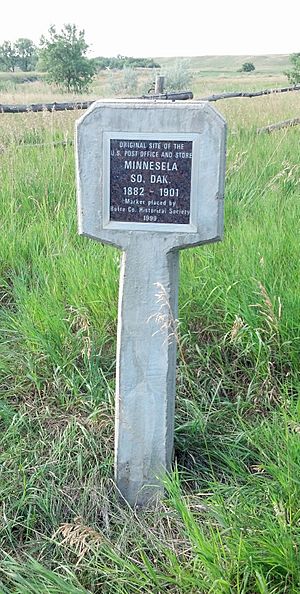Minnesela, South Dakota facts for kids
Quick facts for kids
Minnesela
|
|
|---|---|

Minnesela in 1890
|
|
| Country | United States |
| State | South Dakota |
| County | Butte |
| First settled | 1876 |
| Founded | 1882 |
| Disbanded | 1901 |
| Named for | Lakota: "red waters" |
| Elevation | 3,173 ft (967 m) |
| Population
(2010)
|
|
| • Total | 0 |
| Demonym(s) | Minneselans |
| Time zone | UTC-7 (MST) |
| • Summer (DST) | UTC-6 (MDT) |
| GNIS feature ID | 1173792 |
Minnesela was a ghost town in South Dakota. Its name comes from the Lakota language and means "red water." It was the very first settlement and the main town (called the county seat) in Butte County, South Dakota.
Minnesela was started in 1882. It was located about three miles southeast of where the city of Belle Fourche is today. The town became empty by 1901. This happened because the railroad decided to build its tracks through Belle Fourche instead of Minnesela.
Contents
The Story of Minnesela
How Minnesela Started
In 1876, a pioneer named John T. "Buckskin Johnny" Spaulding and his brother-in-law, Thomas J. Davis, built the first house in the area. It was a two-story log cabin. They built it about two and a half miles southeast of today's Belle Fourche.
The logs for the cabin came from the Black Hills. People had to haul them a long way to the building site. The house had several rooms, including a living room, kitchen, and bedrooms.
The Spaulding and Davis families lived in this cabin. Over the next five years, more settlers came to the area. After Spaulding left, many other families used his cabin until the late 1930s.
In 1881, D. T. Harrison and Azby Chouteau planned out the town of Minnesela. By early 1882, about 100 people lived in the area. They decided to build the town on the east bank of the Redwater River. This spot was about half a mile south of Spaulding's cabin.
Minnesela Grows
In 1882, Minnesela became the county seat for Butte County. This meant it was the most important town for local government. The town grew quickly!
By 1883, Minnesela had many buildings. These included a post office, two saloons, about six stores, a school, and a church. There was also a bank, a hotel, and a flour mill. Interestingly, the school building was made from the old Minnesela jail!
The town even had two newspapers. One of them was called the Butte County Star. A cemetery was started in 1887 north of the town. It has 102 graves.
Minnesela was the only town on the prairies north of the Black Hills. This made it a great place for trading. People in Minnesela had big dreams for their town. They called it "the future big city of the Black Hills" and the "coming Chicago of the Midwest."
Why Minnesela Disappeared
Seth Bullock and his business partner, Sol Star, moved to the area in 1879. They built a large ranch known as the SB Ranch. This ranch became famous for breeding fast trotting horses. In 1881, Bullock planted the first alfalfa crop in the Western United States there.
In 1884, a man named the Marquis de Mores started a stagecoach line. It was meant to connect Deadwood, South Dakota to the Northern Pacific Railroad. A few small buildings, including a saloon, were set up at the SB Ranch for this line. The stage line didn't last long, but the saloon stayed open.
Minnesela had very harsh winters. Snow could pile up as high as two stories! In 1886, a hot, dry summer and a strong winter blizzard ruined crops and killed many animals. By 1887, the people of Minnesela hoped the Fremont, Elkhorn, and Missouri Valley Railroad would come to their town.
In 1890, the railroad started laying tracks north of Whitewood, South Dakota. Minnesela got ready for the train by making new land available for sale. The town's leaders asked Seth Bullock to talk to the railroad company for them.
The railroad wanted free land for their tracks. They liked an 80-acre spot south of Minnesela. A resident named Douglas Sayre quickly rode his fastest horse to the land office in Rapid City. He wanted to claim the land first.
A railroad worker named T. G. Carter also went to Rapid City by train. Carter met Sayre at the land office. Carter offered Sayre $500 for the land. But Sayre laughed and said his price for the "Golden 80" was already over $5,000! By the time Sayre asked for $10,000, no one wanted to buy it.
Seth Bullock then gave a lot of his own ranch land to the railroad. This allowed them to build a train depot on the old De Mores Station site. On August 14, 1890, the last rail was laid, and the railroad began shipping animals.
Belle Fourche was officially started on May 1, 1891. Bullock offered free land to people and businesses from Minnesela. Even though the two towns didn't get along, most people moved to Belle Fourche. Belle Fourche grew very fast. The Butte County Bank was one of the first buildings to move.
In 1894, Minnesela and Belle Fourche competed to be the county seat. Belle Fourche promised to build a courthouse for free. They also brought in over 100 people from outside the town to vote. They kept some voters busy with work and others at the saloons. Because of this plan, Belle Fourche won the election!
To celebrate, a group of cowboys rode to Minnesela and took the county's official books. The Belle Fourche sheriff returned the books until they could be officially moved. By 1901, Minnesela was completely empty and became a ghost town.
What's Left Today
In 1957, the town's flour mill was taken down. In 1960, Spaulding's original cabin was given to the Tri-State Museum in Belle Fourche. The cabin was fixed up and moved to the museum again in 2006. It was repaired once more in 2007 and opened to visitors on June 14, 2007.
Today, the Minnesela Hotel is the only original building still standing. The old town site is now a small farming area near Belle Fourche. In 1999, the Butte County Historical Society placed a sign where the Minnesela post office and store used to be.
Where Minnesela Was
Minnesela is located on the Great Plains. It is about three miles southeast of Belle Fourche in Butte County, South Dakota. It is also about 10 miles north of the Black Hills. The town was built on the banks of the Redwater River. The Minnesela Bridge crosses this river.
How Many People Lived There
In 1882, about 100 people lived in Minnesela. The town's population started to shrink in 1891. By 1901, everyone had left, and Minnesela became a ghost town.





